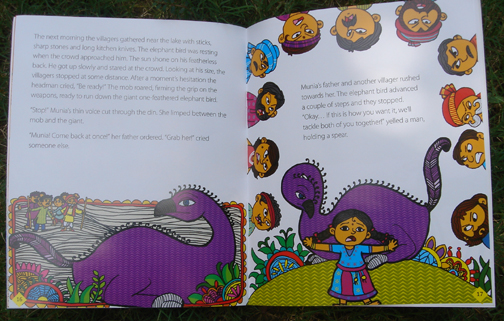Priya Muthukumar sent us this lovely story of using the book 'Paplu, the Giant' during a storytelling session held at Storipur.
After the wonderful response for my storytelling session based on a Caribbean story on our monthly theme, ‘magic’, my search began for a story based on a similar theme, however, I was looking for a story which was fun , with a subtle message incorporated in it. Picking up the book, ‘Paplu, The Giant’ in our local library was my ‘aha’ moment! Flipping through the pages of this thin book, I fell in love with Paplu! From that moment, I knew my young audience would adore Paplu. And that’s how the Paplu journey began for us!
As a storyteller, it was definitely a cherishable moment for me, to see all the kids sit around Paplu’s gigantic dress, cutting and sticking, sharing scissors and glue with the only objective of making Paplu, the friendly giant’s dress! We made Paplu’s dress with old newspapers, calendar sheets and other re-useable scrap pieces of paper. This dress- making activity gave us another opportunity to highlight recycling and our responsibility towards our environment.
We were pleased with Paplu’s dress and the story continued. Paplu’s kindness and strength, both appealed to our kiddos. The words,‘ Priya Aunty, will you tell us another Paplu story, next time! ?”, reconfirmed their love for Paplu. Finally, the kids were asked to draw their own versions of Paplu. And what appeared on paper, was a variety of Paplus, big and small, thin and fat! Many thanks to Team Pratham Books, for introducing us to Paplu! Strength is also about kindness, helping one another, and being there for others was our ‘ take- away’ from Paplu’s story.
After the wonderful response for my storytelling session based on a Caribbean story on our monthly theme, ‘magic’, my search began for a story based on a similar theme, however, I was looking for a story which was fun , with a subtle message incorporated in it. Picking up the book, ‘Paplu, The Giant’ in our local library was my ‘aha’ moment! Flipping through the pages of this thin book, I fell in love with Paplu! From that moment, I knew my young audience would adore Paplu. And that’s how the Paplu journey began for us!
Our kids (3-10 year olds), I must say, listened to Paplu’s story without batting their eyelids. The youngest of the lot, with all innocence, asked me, with wonder brimming in his eyes, ‘but, Priya Aunty, giant means what?’ So, to explain, Paplu’s height, I grabbed a stool, and balanced myself on it and said, ‘Paplu was soooo very tall!”, stretching my hand. The kids added to the story, saying Paplu was as tall as the tree, as tall as a building, he could touch the sky …… and so on and so forth! Our giggles and chatter continuing, non-stop!
Each one in our audience pretending to be a villager in the story, enthusiastically draped the dupattas piled at the corner of the room, on me… standing on the stool, pretending to be Paplu! As the dupattas kept falling down, I announced to the group, Paplu will need a proper dress and that we all needed to make it!
As a storyteller, it was definitely a cherishable moment for me, to see all the kids sit around Paplu’s gigantic dress, cutting and sticking, sharing scissors and glue with the only objective of making Paplu, the friendly giant’s dress! We made Paplu’s dress with old newspapers, calendar sheets and other re-useable scrap pieces of paper. This dress- making activity gave us another opportunity to highlight recycling and our responsibility towards our environment.
We were pleased with Paplu’s dress and the story continued. Paplu’s kindness and strength, both appealed to our kiddos. The words,‘ Priya Aunty, will you tell us another Paplu story, next time! ?”, reconfirmed their love for Paplu. Finally, the kids were asked to draw their own versions of Paplu. And what appeared on paper, was a variety of Paplus, big and small, thin and fat! Many thanks to Team Pratham Books, for introducing us to Paplu! Strength is also about kindness, helping one another, and being there for others was our ‘ take- away’ from Paplu’s story.
Visit the Champions blog for more inspiring stories.
Note : If any of you want to be a Pratham Books Champion and join us on our journey of getting 'a book in every child's hand', write to us at web(at)prathambooks(dot)org.
.jpg)


















.png)

















